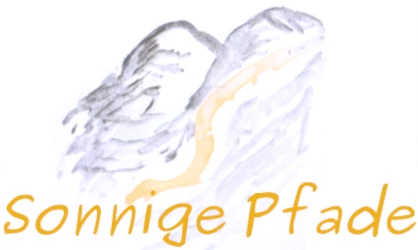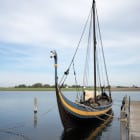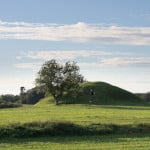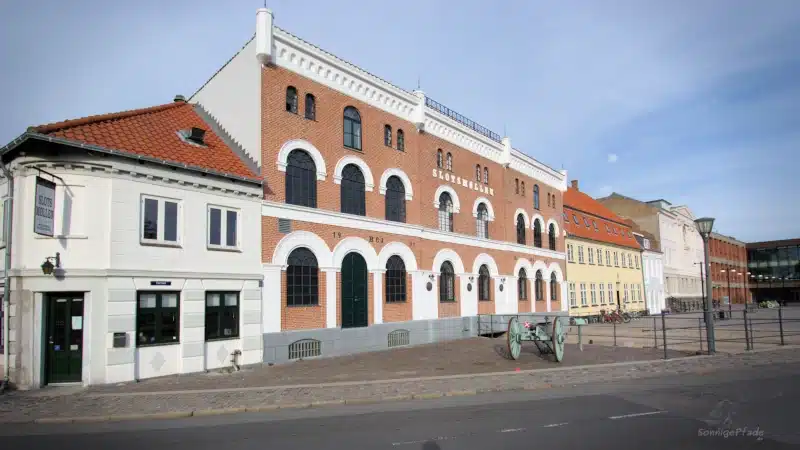
In the east of the island of Funen, but in the middle of Denmark, lies the town of Nyborg on the Great Belt. Nyborg has been a link in the Kingdom of Denmark for centuries, even if the completion of the Great Belt Bridge in 1998 and the closure of the ferry ports has somewhat reduced its importance as a transportation hub. A colorful town center with old merchants‘ houses and Nyborg Castle are well worth a visit to this historic town.
Tranquil town with royal castle – Nyborg
Stroll through the old royal town
A colorful city center
I actually only visited Nyborg on my cycle tour of the Danish islands because I ‚had no other choice‚. Nyborg is still the place in the east of the island of Funen from where you start the leap across the Great Belt to Copenhagen’s island of Zealand. As there are no more ferries, the only option for me as a cyclist is to take the train across the Storebelt bridge and through the tunnel to Korsør.
Encounter with the Egon Olsen gang
Well, I can still do that tomorrow – while I’m there, I’ll take a look at Nyborg: And my visit starts with a surprise – the Egon Olsen Gang is there and shows me the way to the town center! The discovery of the Danish crook trio is worth a stop and a photo shoot! As an „Ossi“ (born East german), I grew up with the Olsen Gang films in the 80s. (They are still shown almost every year on East German TV channels). A new Olsen Gang movie was always a cinema event!
Why is the Olsen Gang in Nyborg and not in Copenhagen? The director Erik Balling, who died in 2005, was from Nyborg. There’s a square named after him on the edge of the pedestrian zone (and of course right next to a cinema) – and that’s where I came across the life-size silhouettes of Egon Olsen, Benni and Kjeld in the light of the low afternoon sun.
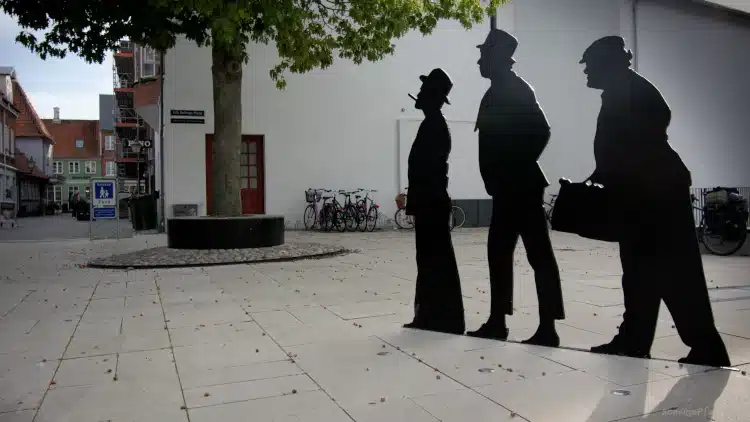
In the pedestrian zone to the market
I enter the pedestrian zone through a side street. Right next to me, there is life in the outdoor seating area of a café. Otherwise, the boulevard makes a quiet impression. Boutiques line the street, interspersed with small cafés and snack bars. At the end of the street, I enter a large square, which turns out to be the marketplace – next to me is obviously the town hall, but unfortunately it is covered in scaffolding.
The market is closed on three sides by rows of houses, but to the west the whole thing opens up into green spaces. There is also a ditch flowing there, which I only really notice when I get closer. The shallow river passes under one of the buildings on the right-hand side of the market development. It’s a box-shaped industrial building with a red brick façade, large windows with white round arches and small turrets on the edge of the roof. As I approach, I recognize the inscription „Slotmølle“ – castle mill, from 1901. Apparently it was operated by water power, at least in the early days. Today there is a theater in the old Nyborg castle mill.
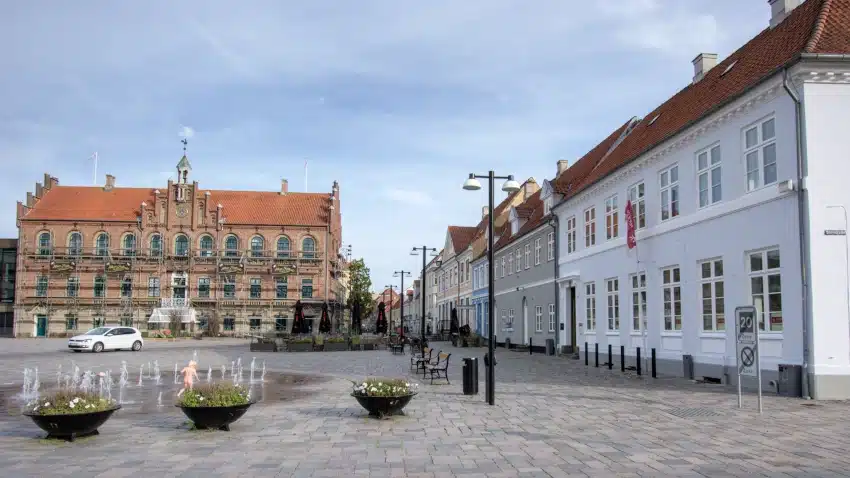
The castle demands imagination
The green areas at the western end of the market square can be reached via a bridge. It is bordered by another brick building – the castle. Or let’s say – a remaining building of the castle. The green areas turn out to be the former castle grounds, on which Nyborg has undertaken a great deal: From archaeological investigation to partial reconstruction of the castle. So far, it takes some imagination to picture the dimensions of the former palace.
However, I turn left before the mill race and walk along the wide arch on the bank. Numerous colorful houses from different eras line the street. Almost straight ahead, I come across a striking red half-timbered house – a typical merchant’s house from the early 17th century. This is Borgmestergården – now Nyborg’s cultural history museum.
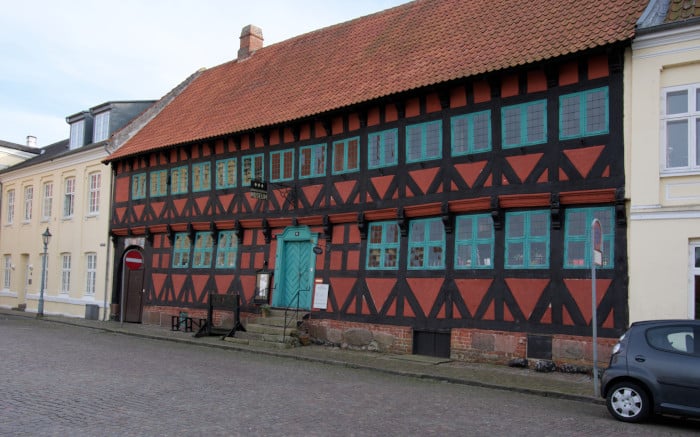
The street and the river complete the U at the castle building. The stepped gable merges into a corner tower on the west side, which gives the building its character. There is also a brick tower at the other end. Nyborg Castle plays a fairly important role in Danish history as a royal palace and seat of parliament, but after 1660 it was used more as a „quarry“ and large parts of it were demolished. For this reason, there is not much to learn about the glorious past from stone witnesses. Behind the castle building, ramparts and trenches tell of the time when the town was a fortress, including during the Napoleonic Wars.
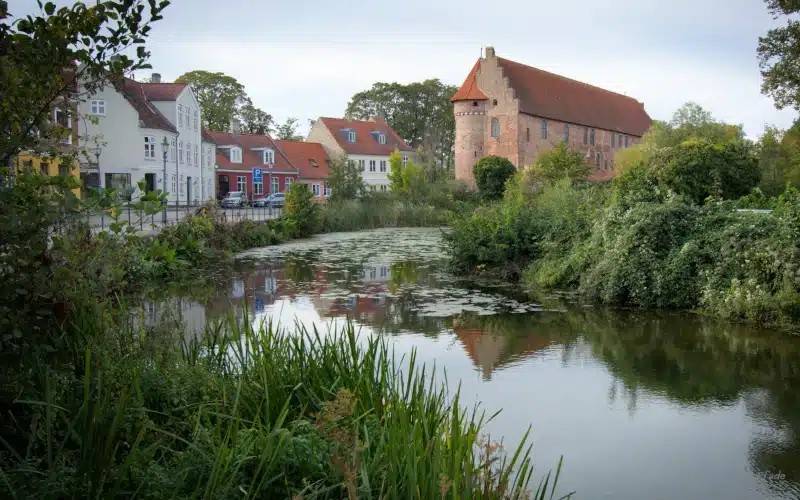
The Church of Our Lady and the harbor of Nyborg
At the other end of the pedestrian zone is Nyborg’s Church of Our Lady, which was completed in 1428. Queen Margaret I of Denmark attended the laying of the foundation stone in 1388. The most striking feature is the square tower with its steep spire, which was not completed until 1589.
Always curious about maritime influences, I turn my attention to the harbor. Directly at the entrance to the harbor facilities stands a small pillar as a reminder of the activities of the Danish Tourist Association – dating back to 1900! As is so often the case, the parts of the harbor close to the city are now largely leisure harbors for local water sports enthusiasts and sailing tourists.
The eastern pier is lined with newly built apartment buildings, some of which offer moorings. I follow the tracks of an old harbor railroad. Behind the apartment complexes, I discover the finger piers of the former ferry berths. The area is deserted, with only a few anglers still standing on the walls and enjoying the peace and quiet that returned 25 years ago. Apparently, the old waiting lanes in front of the ferry terminals and the railroad facilities were built over with the apartment buildings.

Dutch mill on the outskirts of the city
I reach the arterial road heading south via Strandvejen. Nyborg also has its mill here. The Dyrehave Mølle from 1858, together with the complex of residential building and warehouses, has been preserved and is in excellent condition – the listed ensemble was only completely renovated at the beginning of the 2020s.
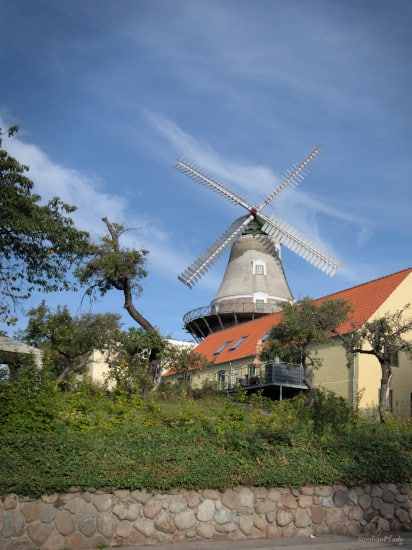
I leave the urban area through a strip of forest and reach Nyborg Fjord. Several photographers with long telephoto lenses are already standing in a parking lot, all excited. As the sun sets, a multitude of water birds flutter across the fjord or swim on the smooth, reflective surface of the water. As I have forgotten my binoculars on this tour and look a little helpless against the big guns of the locals with a small travel zoom lens, I prefer to enjoy the sunset with its impressive cloud formations at the end of the day.
Castle and town history of Nyborg
The history of the town of Nyborg is closely linked to the development around the castle. The town grew up in the shadow of the castle.
When King Waldemar became sole ruler of Denmark in 1157, the construction of castles and palaces began at strategically important locations. There is no doubt that Nyborg, with its location on the Store Belt opposite the large island of Zealand, had such an important position. It is not really known whether the construction of the castle in Nyborg was started from scratch or whether it was built in place of an existing castle. The first written mention of Nyborg Castle is recorded in 1193. In addition to stabilizing Denmark internally, the first task was above all to provide protection against the Wends, Slavic tribes who dominated the eastern part of the mainland on the Baltic Sea at that time.
Meeting place of the nobles – the Danehof
In the first construction phase, the fortifications of Nyborg castle were dominated by ramparts and an almost 10m high curtain wall. The semi-circular towers of the still existing building in the west were also built during this construction phase. In order to flood the moats, water was brought in from Vindinge Å in an elaborate canal system over a distance of almost 5 km, which is still the case today.
With the signing of a ‚Handfeste‘ in 1282, the first constitution for Denmark, jurisdiction was transferred from the king to the Danehof. This assembly of the Danish nobility met at Nyborg Castle between 1250 and 1400. The castle was both a meeting place and a court of law.
The large watchtower, the remains of which are still visible today, was built around 1300. It is said to have been around 35 meters high.
Even when King Erik VII moved to Copenhagen in 1413, Nyborg remained a royal castle.
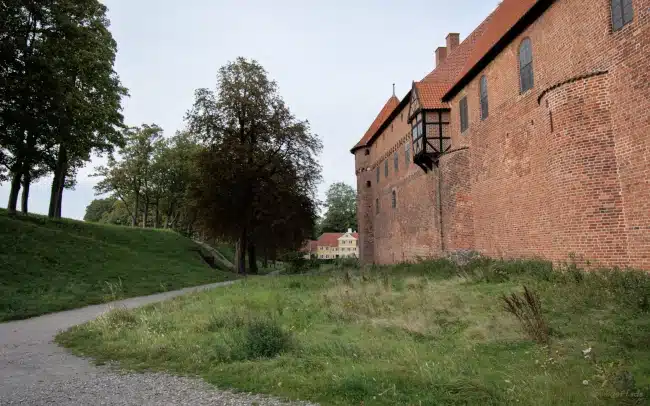
Only a brief renaissance – reconstruction and decay
In 1525, the Imperial Council made Nyborg the first official capital of Denmark. In keeping with the style of the time and the new dignity, the castle was converted into a Renaissance palace. King Christian III wanted to use the conversion of the castle and town as a symbol of the new state religion under the banner of the Reformation. At the same time, the fortifications around the castle and town began to be expanded into a fortress. But after 1560, the castle began to fall into disrepair. The function of the capital was finally lost to Copenhagen.
During the Swedish Wars from 1650 onwards, Nyborg was occupied several times and bombarded by the Dutch. The castle was 3/4 destroyed. In the following period, building material was often removed, for example for the construction of the castle in Odense.
It was not until the beginning of the 20th century that the castle grounds in Nyborg began to be placed under protection and systematically examined archaeologically. Today, around 100 years later, there are ambitious plans to partially rebuild the castle complex. Chamber concerts are regularly held in the preserved Knights‘ Hall during the summer months.
The Church of Our Lady
In addition to the castle, the Church of Our Lady (Vor Frue Kirke) in Nyborg is one of the town’s sights.

Built between 1388 and 1428, it is part of an ensemble of brick buildings at the medieval Korsbrødregård. In the 15th century, the site was still enclosed by a wall to the east. The church has an important new organ built in 1973 by the Danish organ builder Poul-Gerhard Andersen. Parts of two older organs are integrated into it.
The altar cross (2011) in the form of a stylized tree of life and the altar window with a resurrection motif (2015) were created by Danish artist Maja Lisa Engelhardt.
[Contains *advertisement]
Travel tips for Nyborg on Funen
Museums in Nyborg
- Nyborg Castle
- Borgmestergården also: Mads Lerches Gård – art history museum, historic merchant’s house, built from 1601 by the mayor Mads Lerche. Various exhibitions in the house show a cross-section of life in East Funen over the centuries.
- Dyrehave Mølle – Dutch-style gallery mill from 1858 with a complex of buildings (granary, barn, residential building, etc.)
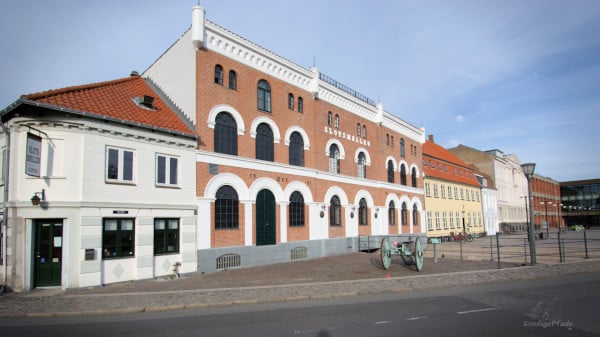
How to get there
Due to its central location in Denmark, Nyborg is easily accessible. The Storebelt Bridge with its highway and railroad line is the most important east-west connection in Denmark and passes directly through Nyborg. However, there have been no ferries since 1998.
By car
The easiest way to get here by car is via the east-west highway E20 (Copenhagen – Fredericia). From continental Europe you can drive toll-free to Nyborg via Jutland and the Funen Bridge (i.e. from the west). The Storebelt Bridge (from the east, Copenhagen) is subject to tolls… at least until around 2034, when the construction costs for the bridge should have been recouped. Exits are Nyborg Vest and Nyborg Ø, the latter being closer to the city center.
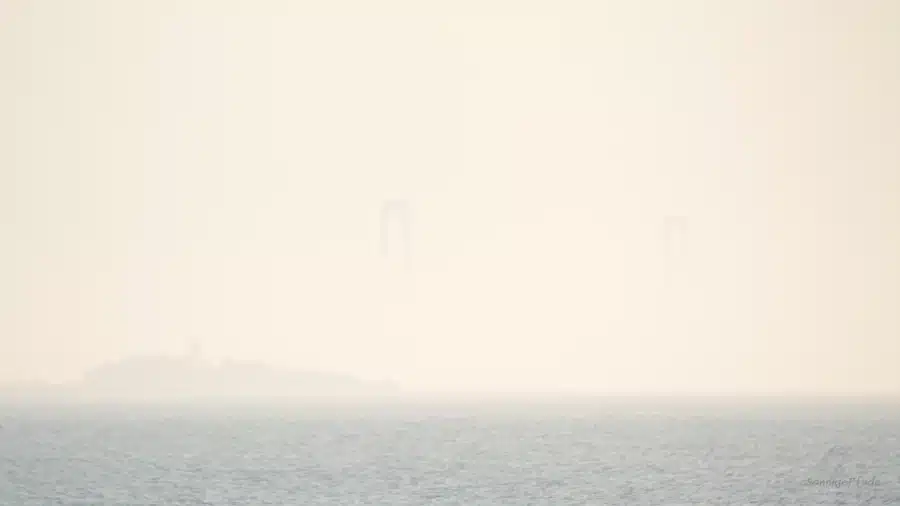
By train or long-distance bus
There are some trains from continental Europe to Sweden, which travel via Funen and Zealand and use the Storebelt and Öresund bridges. One example would be the connection from Hamburg to Copenhagen. You will have to check for yourself whether your desired train also stops in Nyborg. Otherwise you can get off in Odense (the island capital of Funen) and take a Danish InterCity to Nyborg.
There are also long-distance buses* from northern Germany to Copenhagen on the same long-distance route. It also makes sense to get off in Odense and continue to Nyborg either by local train or by bus from Fynbus.
By bike
You can easily cycle to Nyborg on a cycling tour of Funen. There are many smaller roads in Denmark that only serve local traffic and allow for easy cycling. If you are coming from Zealand (from Copenhagen), you will have to take the train from Korsør at the latest to cross the Storebelt bridge. Unfortunately, cycling is not allowed. It is possible to take bicycles on the Danish IC train, but there is a surcharge for bicycles and a space reservation for bicycles, even for the short distance through the tunnel. Both tickets and bike reservations can be obtained from ticket machines, which can also be set to English or German. Payment is by credit card.
Accommodation in Nyborg
Nyborg has several hotels, but mainly vacation homes on the Great Belt.
Birkely is a vacation home* with four bedrooms for up to seven guests. Large windows allow plenty of Baltic sunshine into the house. In the evenings, vacation guests can gather in front of the fireplace. The well-equipped kitchen makes self-catering possible. The nearest restaurant is approx. 500m away. Pets are allowed.
Nice home in Nyborg* is a vacation home with two bedrooms for up to four guests. The house is surrounded by garden, a sun terrace makes the evening cozy. Kitchen for self-catering. Parking lot included. The nearest restaurant is approx. 400m away.
For visitors to Nyborg, the ****Hotel Hesselet* is a good choice. The hotel offers various double rooms and a suite with sea view. Breakfast is included. The hotel has a wellness area with sauna and whirlpool as well as an indoor pool that is open all year round. Exercise in the fresh air is possible on the tennis court. Rail travelers in particular can look forward to a short walk from Nyborg station to the hotel.
The ***Hotel Villa Gulle* offers double rooms and one single room. The hotel is located in a restored old town house with a short walk to the historic center of Nyborg and the castle. Guests can look forward to a very good breakfast for a good start to the day. Parking directly at the house.
Weather in Nyborg
To help you plan your city stroll in Nyborg, you can find the weather forecast for today and three days ahead in the overview opposite.
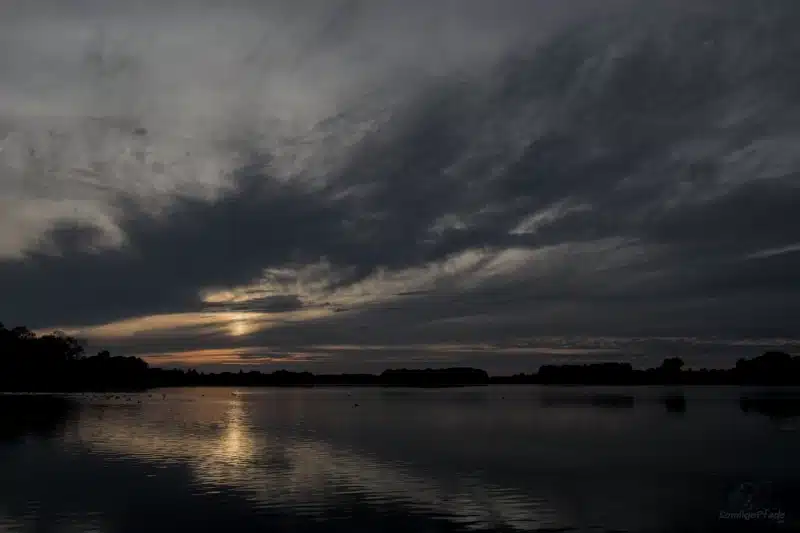
More adventures at the Danish island of Funen
The Ladby Dragon – a ship grave from the Viking Age in the Ladby Viking Museum
Visit the grave chamber in the 5000 years old Mårhøj passage tomb
